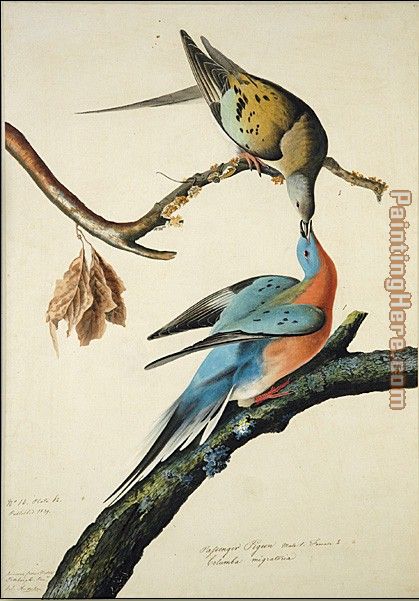Passenger Pigeon
Probably the best-known extinct American bird is the Passenger Pigeon:

Estimates of the total number of passenger pigeons at the turn of the nineteenth century are around 3 billion, 25 to 40% of all the breeding birds in America.
Pigeon migration was a spectacle, as described by John James Audubon:
I dismounted, seated myself on an eminence, and began to mark with my pencil, making a dot for every flock that passed. In a short time finding the task which I had, undertaken impracticable, as the birds poured in countless multitudes, I rose, and counting the dots then put down, found that 163 had been made in twenty-one minutes. I traveled on, and still met more the farther I proceeded. The air was literally filled with Pigeons; the light of noon-day was obscured as by an eclipse, the dung fell in spots, not unlike melting flakes of snow; and the continued buzz of wings had a tendency to lull my senses to repose… Before sunset I reached Louisville, distance from Hardensburgh fifty-five miles. The Pigeons were still passing in undiminished numbers, and continued to do so for three days in succession.

Audubon mentioned them many times in his writings. Here is a description of a portion of one flock returning to their nests:
“The Pigeons, arriving by thousands alighted everywhere, one above another, until solid masses as large as hogheads were formed on the branches all round. Here and there the perches gave way under the weight with a rush, and falling to the ground, destroyed hundreds of the birds beneath, forcing down the dense groups with which every stick was loaded. It was a scene of uproar and confusion.”
The species went from being one of the most abundant birds in the world during the 19th century to extinction early in the 20th century.

Their habitat was reduced by new settlements in the West, but the tipping point came as a result of hunting. Pigeon meat became a popular source of cheap food for the poor and for slaves in the south, leading to large-scale commercial hunting. In Louisville, Audubon wrote that “multitudes were thus destroyed. For a week or more, the population fed on no other flesh than that of pigeons, and talked of nothing but pigeons.” Even the air smelled of them. At the time, Passenger Pigeons had one of the largest groups or flocks of any animal, giving hunters the impression that the supply of pigeons would never run out. In 1805, a pair of pigeons sold for two cents in New York City. Boxcars full of the birds were shipped back east.

The passenger pigeon was a very social bird; it lived in huge colonies stretching over hundreds of square miles, and practiced communal breeding with up to a hundred nests in a single tree. This kind of bird relies on sheer numbers to ensure its survival. There was safety in large flocks; the number of predators was so small compared to the total number of birds, little damage could be inflicted on the flock as a whole. But once their number were reduced beyond a certain point, a slow reduction in numbers quickly transitioned to a catastrophic decline, which is what happened to the bird between 1870 and 1890. As the flocks dwindled, the number of pigeons decreased below the threshold necessary to continue the species. Conservationists who tried to halt the hunting of the passenger pigeon at this point were too late; beyond a certain point, the pigeon had no hope of coming back. Smaller groups of pigeons could not breed successfully, and the surviving numbers proved too few to re-establish the species.
On September 1, 1914, Martha, the last known Passenger Pigeon, died in the Cincinnati Zoo. Her body was frozen into a block of ice and sent to the Smithsonian Institution, where it was skinned, dissected, photographed and mounted. A memorial statue of Martha stands on the grounds of the Zoo.
